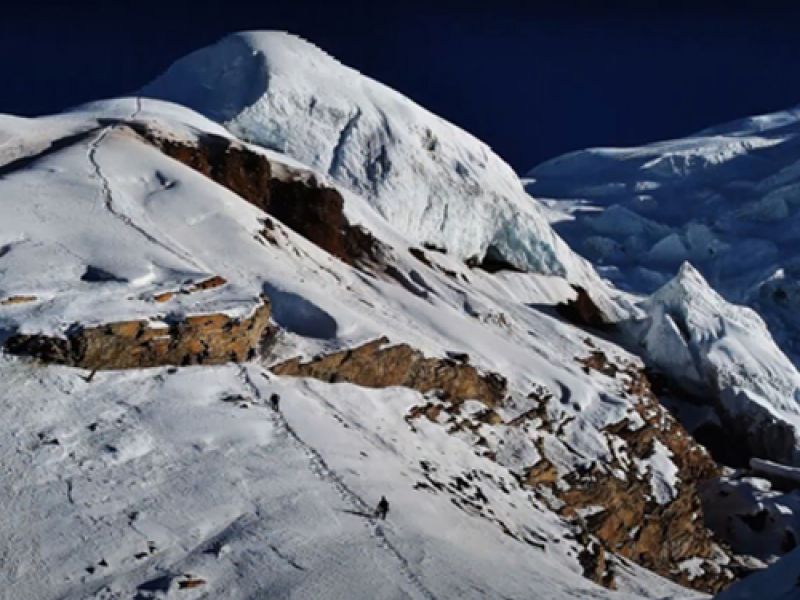Summary of Pisang Peak Climbing
Are you looking for an exciting and adventurous climb in Annapurna Region? The Pisang Peak may fulfil your wish and definitely will be the best choice for any level of climber. This peak is a beginner peak, and if you are climbing for the first time, then this peak will be best for you.
Pisang Peak adds more fun and adventure to Himalaya Trekking Packages. Pisang Peak Himalayas elevation range up to 6091 meters and the base camp at 4380 meters. During the climbing season, temperatures can reach up to 20°C. Furthermore, in winter, people have successfully mounted the mountain.
Although the cold weather may be problematic for some, particularly if you are a novice mountain inhabitant. Although it is true that the mountain is hard physically, it is more dependent on how agreeable you are with the boundaries of the winter months.
On the way to Pisang Peak climbing
Pisang Peak Climbing will start after the adventurous driving from Kathmandu to Dharapani. From Dharapani, our memorable trek to Pisang peak will start. As you climb Pisang Peak, you will embrace the challenge, enjoy the fresh air, and behold the beautiful view of snow-capped mountains. As you reach the top, you will be full of joy and stunned by the panoramic view of Annapurna II (7,939 m), Annapurna III (7,555 m), and Manaslu (8,156 m), Himlung (7,140 m), and many other small peaks.
After the remarkable climb, we will be back and cross the highest pass in the world, Thorang La Pass (5,416 m/17,769 ft). As you cross the pass, you will reach Muktinath Temple. You will be cultivated with joy and peace within and around us as you will walk around the Muktinath Temple. This temple is a famous pilgrimage site holding great importance for the devotees.
You will also get an opportunity to be free from tears, misunderstanding, and suffering from the positive power of the surrounding. Further, we will trek towards Jomsom, take a scenic flight to Pokhara and, from there, drive back to Kathmandu.
How Difficult Is Pisang Peak Climbing
Previous high-altitude trekking or climbing will make it easier to summit Pisang Peak. However, our Sherpa and guide professionals will always be there toescort and provide expert guidelines on climbing. Our professional will also prepare you to use the climbing gears before summiting the peak. An excellent physical condition with passion and a positive attitude will help you to succeed the climbing.
Before climbing, we recommend you have some physical training for 2 to 3 months to enhance your stamina. It also helps you to walk-ups and down easily with a weighted backpack at high altitudes. If you have not done any exercise before, then you have to train yourself a bit harder.
Pisang Peak climbing Accommodation
Unless you desire tents, lodging at the Pisang Peak Climbing might be in fine inns run through nearby locals. Each hotel functions as a primary public area with a fireplace, while the bedrooms are unheated and feature beds and mattresses, in addition to a blanket and pillows. You must bring your very own sleeping bag. The showers are generally powered through gas, and a few use the iconic `drop' toilets, however, maximum now have flush systems.
We'll be camping on the Pisang Peak base camp. We'll be sleeping in mountain tents, which commonly sleep humans consistent with tents. We use a four-season sleeping bag in addition to a high-quality sleeping mat. Lower down, you could need to apply a sleeping bag liner to sleep in an open zipped four-season bag to save you overheating. You will even have your guide and mountaineering sherpa with you the complete time to guarantee your protection and happiness.
Emergency Evacuation in Pisang Peak Climbing
In Nepal, helicopter evacuations are the maximum usual method of managing an emergency, and there may be a well-set-up infrastructure for managing logistics. Incidents are uncommon, and Pisang Peak is positioned in a well-supported area of Nepal.
A helicopter evacuation may be organized through your insurance company. However, you may want to open a case and describe the situation to the insurance company. The best advice withinside the case of altitude sickness is to keep away from risk and descend. Further elevation can quickly result in far more serious cerebral or pulmonary oedema, consequently, it is usually nice to descend if you're feeling truly unwell.
Why Himalayan Odyssey for Pisang Peak Climbing?
The Himalayan Odyssey provides the best Pisang Peak climbing package to make your once-in-a-lifetime journey safer and more memorable. We are an experienced travel provider. Our team is highly-versed in mountain emergency medical care, as well as ascent and trekking.
We put a priority on the quality and well-being of our guests. We guarantee an extra pleasurable adventure with our joyful and helpful staff. Our cuisine, housing, and other services are the first. If you have already done Pisang peak climbing then here list for you more, Isalnd peak climbing and Mera peak climbing.
We want you to succeed, and we're here to help you reach the top of Pisang Peak. It's time to book your Pisang Peak Climbing adventure.





